Understanding local impacts and threats
Detailed studies and surveys on climate change vulnerability of and human-related threats in the sanctuary generated the pre-requisite knowledge needed to develop the management plan and bring stakeholders to a same level of understanding. It generated an improved understanding of the potential impacts of climate change based on local downscaled climate change projections. This work also identified the ecosystem values of the sanctuary with regards to biodiversity, fisheries and other aquatic and non-timber forest products production.
- Availability of data in the literature, from local governments and active involvements and coordination of sub-national governments, esp. relevant provincial departments and commune in field data collection and information sharing.
- Qualified technical staff to analyze results from scientific monitoring on local climate change, biodiversity and livelihoods.
A strong management and adaptation plan has to be based on good scientific knowledge of the site. This requires in general more time than the actual drafting of the plan. Data sources should be a good balance between scientific sources and studies as well as local knowledge and stakeholder consultation (especially on climate events, hazard timelines, local changes in crop productivity, rainfall patterns, etc.).
